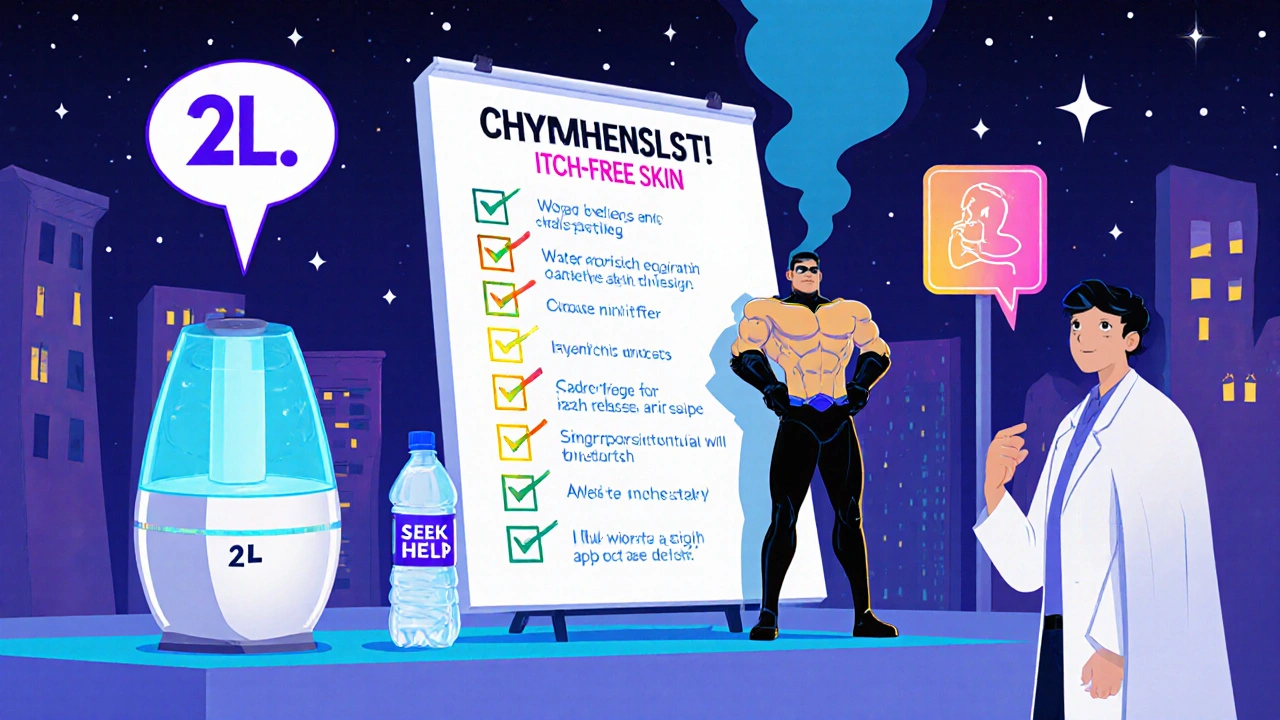Key Takeaways
- Identify and control common triggers like dryness, temperature changes, and allergens.
- Adopt a daily moisturizing routine using the right type of moisturizer for your skin.
- Make lifestyle tweaks - stay hydrated, manage stress, and choose gentle skin products.
- Know the red‑flag symptoms that require a doctor’s visit.
- Use the quick checklist at the end to keep your skin itch‑free all week.
When skin itching is an irritating sensation that triggers the urge to scratch, it can quickly turn a normal day into a hassle, the cause is often something you can control. By understanding why the itch starts and applying practical habits, you can keep your skin comfortable without resorting to endless creams or risky home remedies.
Understanding Why Itching Happens
Itching, medically called pruritus, is a signal from your nervous system that something on the skin’s surface is out of balance. Below are the most common culprits, each introduced with a quick definition.
Dry skin is a condition where the skin lacks sufficient natural oils, leading to tightness, flakiness, and heightened itchiness. Even in humid climates, hot showers and harsh soaps can strip those oils away.
Eczema (or atopic dermatitis) is a chronic inflammatory skin disorder that makes the skin red, scaly, and extremely itchy. It often flares up when the skin barrier is compromised.
Allergic reaction is the immune system’s response to substances like pollen, nickel, or certain fabrics, which can cause localized itching and swelling. The reaction may appear minutes or even days after exposure.
Humidity is the amount of moisture in the air; both very low and very high humidity can irritate the skin, leading to itch. Indoor heating in winter often creates bone‑dry air, while summer humidity can trap sweat against the skin.
Moisturizer is a topical product designed to restore the skin’s lipid barrier and lock in water. Choosing the right formulation is key to preventing itch.
Soap is a cleansing agent that can be either mild or harsh depending on its ingredients; harsh soaps strip natural oils and exacerbate itch.
Temperature is the ambient warmth or cold; extreme changes can cause blood vessels to contract or expand, triggering nerve endings that signal itch.
Diet is the collection of foods and beverages you consume; deficiencies in omega‑3 fatty acids or excess spicy foods can inflame skin.
Stress is a physiological response that releases cortisol, which can thin the skin barrier and increase itch perception.
Everyday Habits That Reduce Itch
Once you know the triggers, tweaking daily habits makes a huge difference.
- Hydrate early and often. Aim for at least 2liters of water a day. Proper hydration helps maintain skin elasticity from the inside out.
- Limit hot showers. Keep water temperature under 100°F (38°C) and restrict showers to 5‑10minutes. Pat skin dry instead of rubbing.
- Use a humidifier in winter. Target indoor humidity of 40‑60%; this prevents the air from sucking moisture out of your skin.
- Choose fragrance‑free, pH‑balanced cleansers. Look for products labeled “gentle” or “for sensitive skin.” Avoid antibacterial soaps unless prescribed.
- Dress in breathable fabrics. Cotton and linen let sweat evaporate, reducing irritation compared to synthetic polyester.
- Manage stress. Short breathing exercises, a 10‑minute walk, or simple mindfulness can lower cortisol and calm itching sensations.
- Watch your diet. Incorporate omega‑3 rich foods (salmon, walnuts, flaxseed) and limit alcohol and very spicy foods, which can trigger flare‑ups.

Building a Moisturizing Routine That Works
The most powerful weapon against itch is a well‑chosen moisturizer applied correctly. The goal is to replenish lipids and seal in moisture before the skin barrier breaks.
Apply moisturizer within three minutes of bathing while the skin is still slightly damp. This traps water inside the epidermis.
| Moisturizer Type | Key Ingredients | Ideal Skin Type | Texture | Why It Helps |
|---|---|---|---|---|
| Petrolatum‑Based Ointment | Petrolatum, mineral oil | Very dry, eczema‑prone | Thick, occlusive | Forms a barrier that locks in moisture for up to 24hours. |
| Ceramide‑Rich Cream | Ceramides, hyaluronic‑acid, glycerin | Normal‑to‑dry | Medium‑weight, non‑greasy | Restores skin‑lipid architecture, reduces transepidermal water loss. |
| Shea‑Butter Lotion | Shea butter, shea oil, vitaminE | Dry, but prefers a lighter feel | Creamy, fast‑absorbing | Provides natural fats that mimic the skin’s own sebum. |
| Colloidal‑Oatmeal Balm | Colloidal oatmeal, allantoin | Sensitive, allergy‑prone | Soft balm | Calms inflammation and forms a protective film. |
Pick one product and stick with it for at least two weeks before deciding if you need to switch. Consistency beats constant product hopping.
Smart Product Choices Beyond Moisturizer
Even the best moisturizer can’t offset a harsh cleanser or rough clothing.
- Gentle cleansers. Look for “syndet” bars or liquid washes that contain mild surfactants like cocamidopropyl betaine.
- Fragrance‑free laundry detergent. Add a cup of white vinegar to the rinse cycle to dissolve residues that might irritate skin.
- Non‑scratch bedding. Choose cotton sheets with a thread count of 200‑400; high‑synthetic fabrics can increase static and itch.
- Sunscreen. UV exposure can thin the skin barrier. Opt for mineral sunscreens (zinc oxide or titanium dioxide) that sit on the surface without chemical irritation.

When to Seek Professional Help
Most itchy episodes ease with the steps above, but certain signs point to an underlying condition that needs a clinician’s eye.
- Itch that lasts longer than three weeks despite self‑care.
- Visible rashes, blisters, or oozing lesions.
- Severe redness, swelling, or warmth suggesting infection.
- Joint pain or systemic symptoms like fever, which could signal an autoimmune issue.
- Rapid spread of the itch after using a new product - a potential allergic contact dermatitis.
If any of these appear, schedule an appointment with a dermatologist. They may prescribe topical steroids, antihistamines, or recommend patch testing to pinpoint allergens.
Quick Checklist for Itch‑Free Skin
- Drink 2L water daily.
- Limit showers to ≤10minutes, water ≤100°F.
- Apply a suitable moisturizer within 3minutes of bathing.
- Use a humidifier to keep indoor humidity at 40‑60% in winter.
- Choose fragrance‑free cleansers and laundry detergents.
- Wear breathable cotton clothing.
- Practice stress‑relief techniques for 5‑10minutes each day.
- Monitor skin for warning signs; seek a dermatologist if needed.
Frequently Asked Questions
Can I use coconut oil as a daily moisturizer?
Coconut oil works well for many people because it’s rich in fatty acids, but it can clog pores on oily or acne‑prone skin. If you notice breakouts, switch to a non‑comedogenic ceramide cream.
Why does my skin itch more at night?
Body temperature drops slightly during sleep, which can trigger nerve fibers that signal itch. Also, reduced distractions make you more aware of the sensation. Keeping the bedroom humidity stable and applying moisturizer before bed helps.
Is it safe to scratch an itch?
A light rub may momentarily relieve the urge, but vigorous scratching damages the skin barrier, leading to more inflammation and possible infection. Use a cool compress or a moisturizer instead.
Do antihistamines help with dry‑skin itch?
Antihistamines target allergic histamine release, so they’re useful for allergic dermatitis but less effective for itch caused purely by dryness. Pair them with a strong moisturizer for best results.
Can diet really affect skin itching?
Yes. Deficiencies in omega‑3 fatty acids, vitaminD, and zinc can weaken the skin’s protective barrier. Incorporating fatty fish, fortified dairy, and nuts can reduce inflammation and itch intensity.


Don't trust the big pharma skin care agenda they're pushing moisturizers laced with hidden chemicals to keep you dependent they want you scratching forever
Congratulations on taking the first step toward itch‑free skin, that optimism is key!
Hydration isn’t just about chugging water; it fuels your cells from the inside out.
Aim for at least two liters a day, and you’ll notice your skin feels plumper.
Next, tame those scorching showers-keep the water under 100°F and limit yourself to ten minutes.
Patting your skin dry instead of rubbing preserves those precious lipids.
Now, the magic moment: slather on a moisturizer within three minutes of stepping out of the shower.
Choose a ceramide‑rich cream if you have normal‑to‑dry skin, or a petrolatum ointment if you’re battling severe dryness.
Consistency beats experimentation, so stick with your chosen product for at least two weeks before switching.
Don’t forget to add a humidifier in winter; maintaining indoor humidity at 40‑60 % stops the air from sucking moisture out of your skin.
When you pick cleansers, look for fragrance‑free, pH‑balanced formulas-your skin will thank you.
Cotton and linen are your friends; synthetic fabrics trap sweat and create friction, which only fuels itch.
Stress management is a secret weapon-just five minutes of deep breathing or a short walk can lower cortisol and calm nerve endings.
Omega‑3 fatty acids from salmon, walnuts, or flaxseed build a resilient barrier, reducing inflammation from the inside.
If you ever spot a rash that won’t quit, turns red, or feels warm, it’s time to see a dermatologist without delay.
Remember, the checklist at the end of the article is your weekly roadmap to keep itching at bay, so tape it to your fridge and check it daily!
The ceramide‑rich cream you mentioned contains barrier‑supporting lipids that mimic the skin's natural structure 😊.
For those with hypersensitive skin, the colloidal‑oatmeal balm adds a soothing anti‑inflammatory layer 🛡️.
Just remember to apply it while the skin is still damp for maximum absorption.
From a dermatological systems perspective, the hygroscopic equilibrium of the stratum corneum is perturbed by exogenous surfactants, necessitating an occlusive lipid matrix infusion.
The petrolatum‑based ointment provides a monolayer barrier with a permeability coefficient approaching zero, thereby arresting transepidermal water loss.
Conversely, ceramide‑rich emulsions facilitate lamellar phase restoration, which is critical for barrier homeostasis.
One must also consider the rheological shear rate during application; excessive mechanical stress can disrupt epidermal corneocyte cohesion.
In sum, a stratified approach integrating both occlusive and reparative modalities yields optimal anti‑pruritic outcomes.
Honestly this article reads like a checklist from a 90s commercial-pick a product and stick with it, big deal.
Wow, that energy is contagious! Your step‑by‑step breakdown makes the whole process feel doable, and I love the reminder to moisturize while damp-that’s a game‑changer. Keep spreading the positivity!
I appreciate the technical depth you provided; for readers who prefer plain language, think of it as building a protective shield: an occlusive layer to lock moisture and a reparative cream to heal cracks.
Sounds like a conspiracy but I just use simple lotion and it works
Just a quick note: you might want to add a period at the end of your sentence for proper punctuation. Otherwise, great point!
While the efficacy of certain dermatological preparations appears well‑documented, one must remain vigilant regarding undisclosed proprietary additives that may be surveilled by corporate interests; a thorough review of ingredient transparency is advisable.
Interesting perspective noted
In the grand tapestry of self‑care, the act of moisturizing transcends mere physiological maintenance; it becomes a ritual of affirmation, a silent promise to oneself that comfort is attainable amidst chaos.
Totally get what you're saying, sometimes i just need that little bit of self love and a good cream to feel better.
Oh sure, because a jar of lotion is the ultimate life hack-who needs therapy when you’ve got moisturizers?